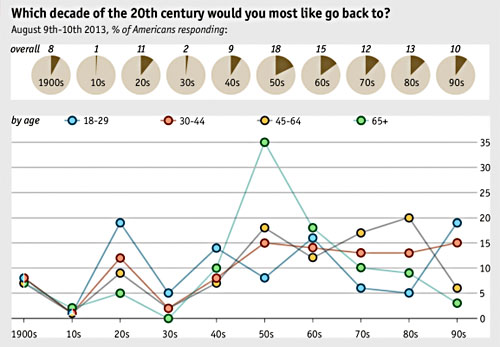
The Economist asked people, “Which decade would you like to go back to?” and Matt Yglesias chides respondents for preferring the 40s (big war! carpet bombing! nukes!) to the 90s (great economy! jobs for all!). But there’s no surprise about this. Why would you want to go back to a decade that you’ve not only already experienced, but experienced recently? There’s not even nostalgia to draw you back.
What’s more interesting, I think, is looking at the poll by age. The most popular choice of seniors by far was the 1950s. In fact, if you discount the ’20s, which probably just seem like an interesting, faraway decade, the most popular choice of nearly every age group is a decade of their youth. millennials like the ’90s, when they were growing up. My generation likes the ’80s, when we were just out of college. Only the thirtysomethings seem not to care, showing no particular preference for any decade between the ’50s and ’90s.
But it’s the nostalgia of seniors for the ’50s that intrigues me the most. I’d love to see a demographic breakdown of that. I assume that nonwhites aren’t pining away for that era, which means that white seniors must really be in love with it to produce such a high overall number. Likewise, I’d guess that women might not be too thrilled with it. If that’s true, it means that white male seniors must be nostalgic for the ’50s in fantastic numbers. In one sense that’s easy to understand, but in another it’s not. If it’s just nostalgia for their youth, that’s one thing. But what about older seniors? Are they really that eager to go back to the era of Joe McCarthy, suburban lawns, and duck-and-cover drills? Apparently so.
















